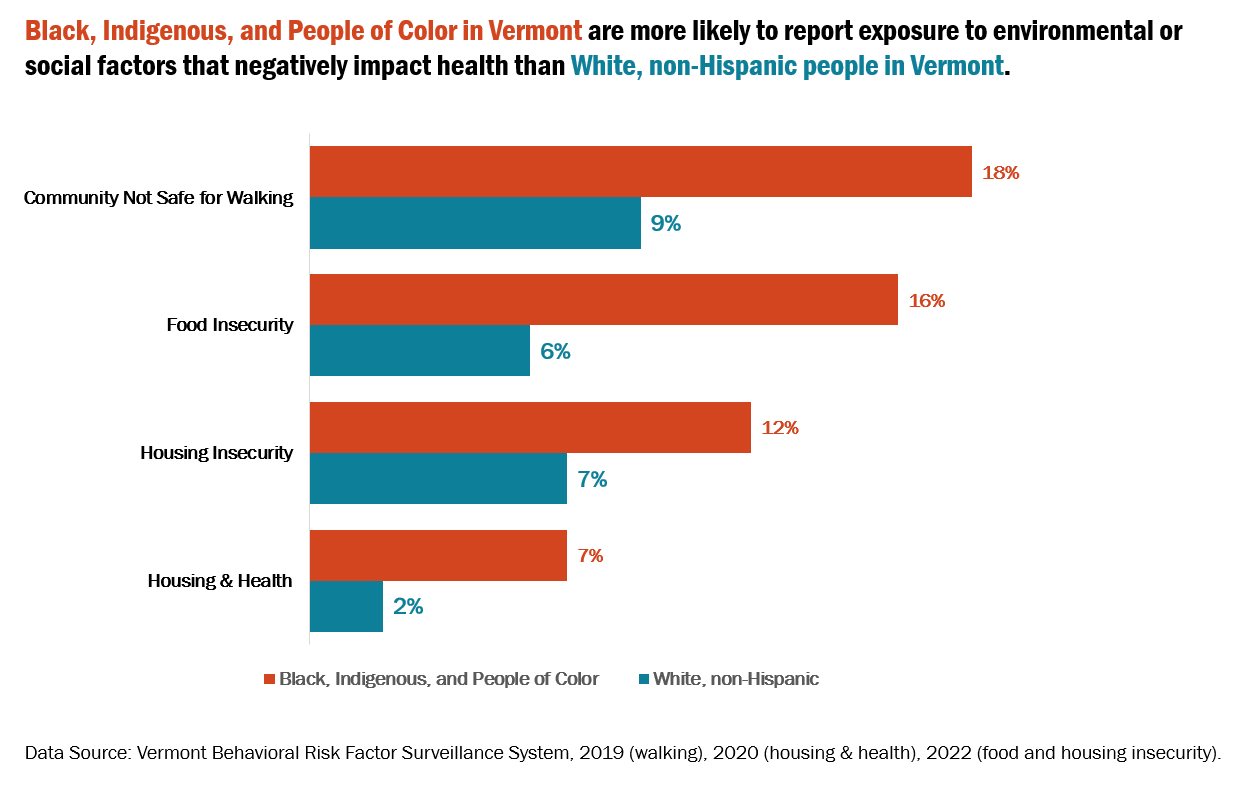The environment plays a significant role in our health
Environmental factors such as clean air and water are fundamental to all human health and well-being. But environmental benefits and burdens are not evenly distributed in society or in Vermont.
In 2022, Vermont passed the Environmental Justice Law (Act 154), which seeks to identify, reduce and eliminate environmental health disparities to improve the health and well-being of all Vermont residents. The purpose of Vermont’s Environmental Justice Law is to ensure all Vermonters, regardless of race, cultural background, or income, have equitable access to environmental benefits. It also seeks to protect communities from disproportionate environmental burdens. Learn more about the law
What are environmental benefits and burdens?
This table lists some examples to help you understand how environmental benefits and burdens impact human health. For example, having clean air benefits health, whereas polluted air can lead to asthma.
| Environmental Benefits | Environmental Burdens | Health Burdens |
|---|---|---|
| Clean air and water | Polluted air and water | Polluted air can lead to asthma and polluted water can lead to a variety of illnesses. |
| Access to nutritious, safe and affordable food | Lack of access to nutritious, safe and affordable food | Lack of access to nutritious, safe and affordable food may result in food insecurity or malnutrition. |
| Adapting to climate change | Exposure to extreme weather events/climate change — wildfire smoke, flooding, extreme heat, extreme cold | Exposure to weather events caused by climate change, like wildfire smoke or extreme heat, can be linked to health effects like asthma, heat-related illnesses and other illnesses. |
| Access to green space | Limited access to green space | Limited access to green space can lead to spending less active time outside or enjoying a neighborhood park. Less time outdoors can lead to physical and mental health impacts. |
| Access to affordable, safe and healthy housing | Old housing stock (for example, with lead and asbestos hazards), unaffordable housing | Limited access to affordable, safe and healthy housing can lead to illnesses or symptoms that are made worse by conditions in the home, such as air quality, mold, pests, or the inability to heat or cool the home. |
Environmental Injustice in Vermont
Environmental injustice exists in our country and in Vermont because systemic racism is embedded in housing, economic and educational practices and policies. This results in People of Color being disproportionately exposed to environmental hazards. Adult Black, Indigenous, and People of Color (BIPOC) living in Vermont are more likely to report that environmental or social factors negatively impact their health when compared to white, non-Hispanic groups, according to data from the 2019-2020 Vermont Behavioral Risk Factor Surveillance System Survey.

The disparities observed in the distribution of burdens and benefits have direct links to health outcomes. For example, as seen in the graph, BIPOC people in Vermont are more likely to report:
- Feeling communities are not safe for walking. This may translate to spending less time being active outside or even spending less time enjoying a neighborhood park.
- Sometimes running out of food and not having money to get more. This may lead to increases in stress hormones, leading to higher blood pressure, fatigue, higher risk of heart disease, weaker immune system, etc.
- Worrying about being able to pay mortgage, rent or utility bills. This may also lead to increases in stress hormones, leading to higher blood pressure, fatigue, higher risk of heart disease, weaker immune system, etc.
- Having an illness or symptom that was made worse by the conditions in homes, such as air quality, mold, pests, or inability to heat or cool homes. Such home conditions may lead to respiratory issues or asthma. Additionally, home conditions may be worse in rented or temporary housing where the resident has limited control over home environments.
